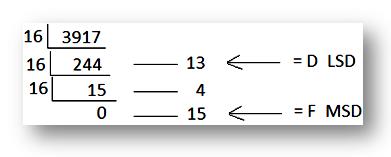Subscribe to our ▶️ YouTube channel 🔴 for the latest videos, updates, and tips.
Hexa-decimal Number System
The hexa-decimal number system has a radix or base 16. It requires 16 symbols to represent a number in this system. The symbols are 0 to 9, A, B, C, D, E, F where the symbols A, B, C, D, E, F represent the decimal numbers 10, 11, 12, 13, 14, 15 respectively. Let us recall the conversion table for the decimal numbers 0 to 15 and their binary, octal and hexa-decimal equivalents.
The conversion of hexa-decimal numbers to their decimal equivalents is straight-forward and follows the same rules as that of octal or binary to decimal. Similarly, conversion of decimal to hexa-decimal may be worked out with the help of division or multiplication, as the case may be, by the radix 16.
The example on hexa-decimal number system will help us to understand the procedure:
1. Convert B6A16 to its decimal equivalent.Solution:
B6A16
= 11 × 162 + 6 × 161 + 10 × 160
= 2816 + 96 + 10
= 292210
Therefore, B6A16 = 292210
2. Convert 391710 to its hexa-decimal equivalent
Solution:
391710

Therefore, 391710 = F4D16
- Why Binary Numbers are Used
- Binary to Decimal Conversion
- Conversion of Numbers
- Hexa-decimal Number System
- Conversion of Binary Numbers to Octal or Hexa-decimal Numbers
- Octal and Hexa-Decimal Numbers
- Signed-magnitude Representation
- Radix Complement
- Diminished Radix Complement
- Arithmetic Operations of Binary Numbers
From Hexa-decimal Number System to HOME PAGE
Didn't find what you were looking for? Or want to know more information about Math Only Math. Use this Google Search to find what you need.


New! Comments
Have your say about what you just read! Leave me a comment in the box below. Ask a Question or Answer a Question.